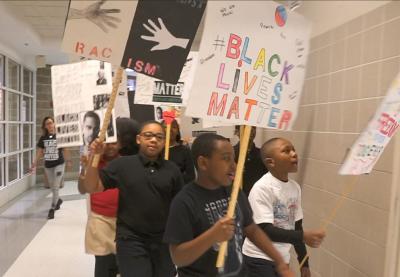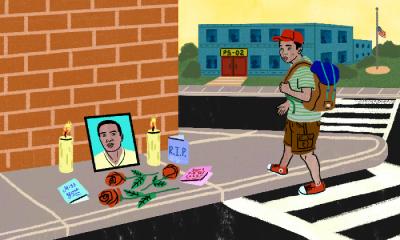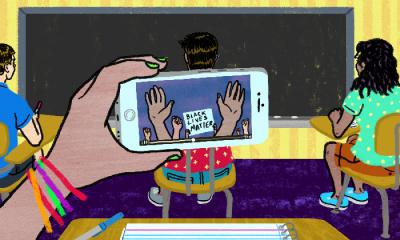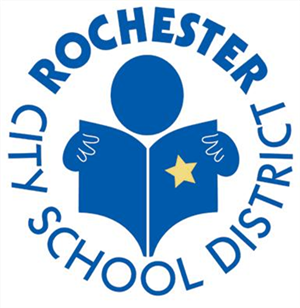In September 2016, the opening fanfare of a high school soccer game in Rochester, New York, was interrupted when 18 varsity boys’ soccer players took a knee during the national anthem. These players, who attend World of Inquiry School, were protesting racial injustice and police brutality. Their action was inspired by San Francisco 49ers quarterback Colin Kaepernick’s ongoing national anthem protest, which he had begun a month earlier at an NFL preseason game.
The protest kick-started the grassroots organizing efforts of a small group of Rochester City School District (RCSD) teachers, parents, administrators and community members. Inspired by the students’ passion, the group decided to take action that would send a message to all students in the district: Rochester schools believe that black lives matter. Their work eventually evolved into a full-day event: “Black Lives Matter at School: A Day of Understanding and Affirmation,” observed districtwide on February 17, 2017.*
The story of how the Day of Understanding came about is a valuable example of collective action within a school district for racial justice and racial equity.
Teacher Leadership
Chris Widmaier, a science teacher at World of Inquiry and a 2016 recipient of the Teaching Tolerance Award for Excellence in Teaching, was one of the leaders of the organizing efforts. “[The district] needed to do something to really educate everybody about why they took a knee, what the significance is, what the controversies were,” he says. “We tried to do that in our own way here at our school, but I saw a need for a larger response.”
Widmaier reached out to teachers and parents across the district. Together they researched the “Black Lives Matter at School” rallies in Seattle Public Schools, which were endorsed by the teachers union and involved more than 2,000 educators calling for racial equity in education. Widmaier and his colleagues asked themselves, What would something similar look like in Rochester?
After connecting with educators in Seattle to help determine their next steps, the group formed an organizing committee, which started to meet every other Sunday in the café area of a local grocery store.
Widmaier, who is white, saw the committee meetings as a space to engage in dialogue about race and racism, and to be critically conscious about what advocating for Black Lives Matter looks like in a district where, as of the 2015–16 school year, close to 60 percent of students are black and 75 percent of the teaching corps is white.
“We agreed, from the very beginning, Black Lives Matter is about self-determination. It’s about black voices being out front,” Widmaier says. “We knew that it was a tricky line … because we’re trying to educate and help students who are black find a voice and find leadership. In a way that’s empowering rather than co-opting.” He notes that key partners for the committee were local Black Lives Matter activists in Rochester, two of whom joined the committee.
Kirstin Pryor, an administrator in the Office of School Innovation and the parent of two RCSD students, joined the committee because she witnessed a profound disconnect.
“I knew that my 13-year-old daughter and her friends were talking about Black Lives Matter at home, at swim practice, in the backseat of the car, and yet their classes weren’t always engaging in a conversation,” she says.
For Lowan Brown, the assistant principal at Joseph C. Wilson Foundation Academy, the committee offered a much-needed outlet. In July 2016, when two black men—Alton Sterling in Baton Rouge, Louisiana, and Philandro Castile in Falcon Heights, Minnesota—were killed in police-involved shootings within a day of each other, Brown felt compelled to take direct action. “I knew I could no longer just sit on my hands and do nothing,” she says. “Students really didn’t have a venue or an opportunity to discuss the loss of black lives that was occurring, not only nationally, but in their community.”
A Plan of Action
The committee—a core group of about 12 people—sought to establish a district-wide day that affirmed the value of black lives and the concerns driving the organizing agenda of the Black Lives Matter movement.
“We talked about how we could use it as a galvanizing tool to bring really thoughtful, powerful discussions about race, racial justice into our classrooms for a day, and then use that as a platform for bringing about change on a broader level,” says organizer Mahreen Mustafa-George, an RCSD parent.
Through our collective participation … students will learn that their school district: understands inequities based on race; affirms that the lives of people of color matter; believes that we all have a responsibility to work for equity.
The committee drafted and presented a resolution before the Rochester Teachers Association’s Representative Assembly. The resolution states, “[S]chools should be places for the practice of equity, for the building of understanding, and for the active engagement of all in creating pathways to freedom and justice for all people.” It passed unanimously, with the association endorsing and encouraging district teachers to participate in a “day of understanding” that affirms that black lives matter at school.
Shortly thereafter, the Rochester Board of Education and Association of Supervisors and Administrators of Rochester voted to adopt similar resolutions, making “Black Lives Matter at School” an official initiative of the district.
Building Capacity
With “Black Lives Matter at School” on the calendar, the organizing committee and senior district leadership focused on communicating its purpose to staff, families and students. They also began building adult capacity and leadership so that educators would approach the day feeling prepared to talk about race and racism.
In a letter to all staff, the district superintendent and senior district leaders articulated the vision for the day: “Through our collective participation … students will learn that their school district: understands inequities based on race; affirms that the lives of people of color matter; believes that we all have a responsibility to work for equity.”
To encourage staff participation (which was voluntary) and to showcase that Black Lives Matter is a teachable topic, the committee worked with Stephen LaMorte—RCSD’s executive director of social studies—to develop an online instructional resource toolkit. Intended to be used by any RCSD educator, the toolkit offers resources for preparing to facilitate conversations about Black Lives Matter, race and racism; lesson plans, activities and peace circle scripts; and materials to continue conversations about racial (in)equity beyond the day of affirmation.
“We really wanted to make sure that there was something for everybody depending on their comfort level,” LaMorte says. “We have over 2,400 teachers. That's just teaching staff, not including paraprofessionals or teaching assistants, or principals and administrators. Everybody has a very different level of understanding around these topics.”
Recognizing that staff members’ critical awareness around issues of race, bias and structural racism varied, the district offered some professional development opportunities. At one of these sessions, led by Widmaier, local Black Lives Matter activists shared their stories with teachers, followed by a group viewing and discussion of the Teaching Tolerance webinar Let’s Talk! Discussing Black Lives Matter With Students.
This learning did not happen in a vacuum, organizer Pryor points out. Over the last couple of years RCSD has been working with Joy DeGruy—a national expert on racism and historical trauma—to train teachers in anti-racism and culturally responsive practices. That work has dovetailed with the district’s shift toward restorative justice practices, as well as the 2016 hiring of a new superintendent, Barbara Deane-Williams, who envisions RCSD becoming “a national leader in educational equity.”
Understanding and Affirmation
In a district with 50 schools and close to 30,000 students, “Black Lives Matter at School: A Day of Understanding and Affirmation” was observed in many different ways but not across the board. For some students, each of their periods focused on “Black Lives Matter at School,” while others had one or a few classes that centered on the day. In some instances, educators and support staff opted not to participate for reasons ranging from parental or community pushback to personal discomfort or opposition to teaching about Black Lives Matter.
To help district leaders and committee members address this type of pushback, assistant principal Brown suggested the following language: “If you are not developing relationships with your students and if you’re not culturally responsive to their needs, no matter how much teaching you do, you’re not really going to engage with them, provide engaging instruction or get students to really listen to you.”
At Brown’s school—Wilson Foundation Academy—about three-fourths of the teaching staff participated in the day. To engage the entire school community, Brown invited a local artist to “live paint” a piece reflecting Black Lives Matter in the cafeteria.
Fifth-grader Aaliyah** at Wilson Foundation Academy was an active participant in the day. “[Kids] should know that they matter—no matter what race they are,” she says. “And we should just stop killing black people and getting away with it.”
Aaliyah, along with all fourth- and fifth-graders, participated in a demonstration around the school building, chanting “Black lives matter!” and “Freedom!” while holding handmade signs. “That raised the hair on the back of my neck,” says Brown. She explains that one of her teachers led those efforts—with the elementary students first learning about historical examples of protests and sit-ins before taking part in the activities themselves.
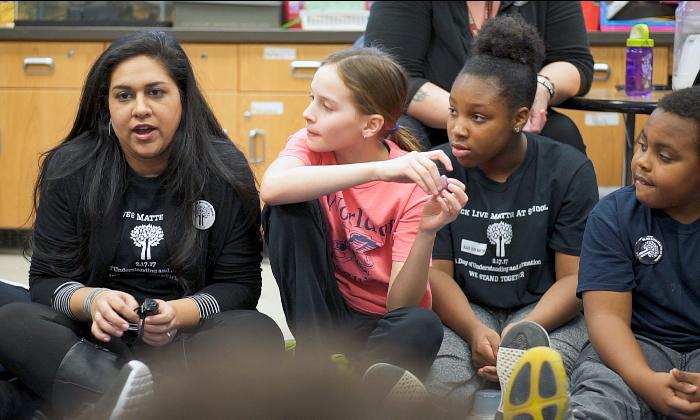
At Northwest Senior High School on the Douglass Campus, a social studies teacher and his students analyzed Ava DuVernay’s documentary film 13th in peace circle discussions. A school counselor and a school administrator also participated in this activity. On the same campus at Northwest Junior High School, an eighth-grade science class and a seventh-grade social studies class listened to and evaluated Jesse Williams’ acceptance speech for the 2016 BET Humanitarian Award. In peace circles, students shared their own experiences with prejudice and being misunderstood.
Brandon White, a teacher on special assignment to implement restorative practices at the Douglass Campus, facilitated the documentary film and speech analyses. His work centers on building the campus’ capacity in utilizing peace circles. He says, “I think it’s important to have those conversations in schools because, oftentimes, they get inherently silenced when they go into school. There’s no talk about what happened with the latest police shooting. There’s no talk about what happened during the election. … Students feel the silence.”
To White, discussing race and racism at school fosters critical thinking and empowerment. Many of the activities facilitated during “Black Lives Matter at School” allowed students to, in his words, “become authentic learners of self and community.” Some examples include:
- Students as young as kindergartners learning about youth activism and responding to questions like “What’s a value that you can stand for?”
- Students engaging in peace circle discussions around such questions as “What does Black Lives Matter mean to you?” and “Why are we doing this today?”
- An eighth-grade science class learning about redlining and housing inequities by looking at historical documents from their own neighborhoods.
- A district-wide art contest with the theme “What does Black Lives Matter mean to you?” open to students in grades 7–12.
- An English teacher using videos and poetry, including “The Average Black Woman” by Ernestine Johnson, to engage middle school students in conversations about Black Lives Matter and identity.
- Teachers inviting in guest speakers and community members to talk to their students about racism and racial inequity.
Looking Back, Looking Forward
Reflecting on the day as a whole, Widmaier says, “[I]t has brought together a community of people … looking at ‘What does affirming that black lives matter at school mean?’ and ‘What does it really mean to understand the experiences of black students at our schools?’” He adds, “I think that we really have recognized the need for student voice. There was awareness of it, but building in student leadership to all aspects of our school—not just initiatives like this—I think a lot of people had that thought or analysis.”
Widmaier attributes the success of “Black Lives Matter at School” to two key strategies: One, the committee members clearly identified the why and how of the organizing efforts; and, two, the committee engaged a broad coalition of stakeholders from the very beginning.
It is not a coincidence that the grassroots organizing for “Black Lives Matter at School” was initially spurred by the action of student athletes, and that one of the largest takeaways from the day is the importance of elevating black student voices. This takeaway sends a crucial message to educators across Rochester and the United States about how to shape their work going forward: Not only do black lives matter, but in order to work toward racial equity and racial justice in schools, education stakeholders must create spaces, initiatives and curricula that affirm, amplify and honor black voices and experiences—within their communities and beyond.
*According to RCSD, this day was not associated with the national Black Lives Matter movement.
** Student's name changed for anonymity.
Resources for Educators
These suggested resources are drawn from RCSD’s online instructional resource toolkit for “Black Lives Matter at School: A Day of Understanding and Affirmation.”
Educating Yourself
- Let’s Talk! Discussing Race, Racism and Other Difficult Topics With Students
- How a Hashtag Defined a Movement
- Black Lives Matter Co-Creator on the New Civil Rights Movement
Classroom Resources
- Looking at Race and Racial Identity Through Critical Literacy in Children’s Books (elementary)
- Different Colors of Beauty (elementary)
- BLM Lesson Series (secondary)
- Racial Disparity in the Criminal Justice System
